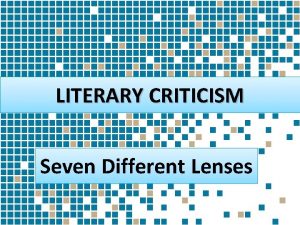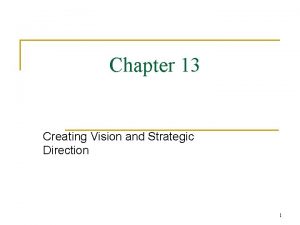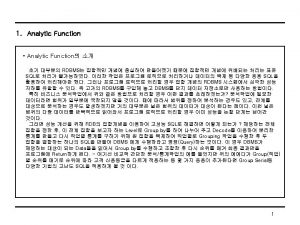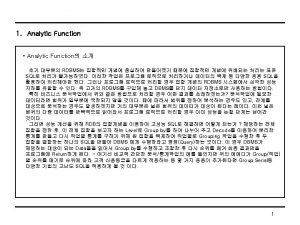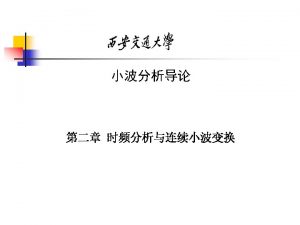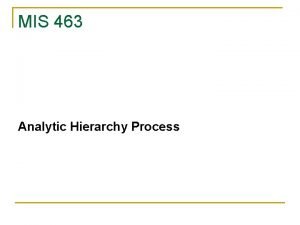Analytic studies Analytic studies focuses on the determinants




































- Slides: 36

Analytic studies

Analytic studies focuses on the determinants of a disease by testing the hypotheses formulated from descriptive studies, with the objective of judging whether a particular exposure causes or prevents the disease

How? By using an appropriate comparison group

Types of Analytic Studies • Observational study ØThe investigator simply observes the natural course of events • Intervention study ØThe investigator themselves allocate the exposure and then follow the subjects for the subsequent development of disease

Types of observational studies • Two basic types: – Case control study – Cohort study

Types of observational studies Ø In theory it is possible to test a hypotheses using either design strategy Ø In practice we need to chose one as each design offers certain unique advantages and disadvantages

What is the key difference between these two designs? The process of subject selection

Cohort Study

Cohort study • Subjects are selected and divided into two groups on the basis of the presence or absence of exposure to a particular factor

Two groups of people in cohort study • A group of individuals who are exposed to a particular factor of interest • Exposed • A group of individuals who are not exposed to a particular factor of interest • Unexposed ØThe two groups are followed for a specified period of time ØThe duration of follow-up depends on how common or rare the disease is

Must Remember : Cohort Study Both exposed and unexposed group will be disease or outcome free ( out come of our interest) for prospective cohort Study.

Types of cohort study “It depends on when the investigation begins” • The investigation begins at a point in time when the exposure has occurred but the disease has not occurred yet • Prospective cohort study • The investigation begins at a point in time after both the exposure and disease have already occurred • Retrospective cohort study

Prospective cohort study: Example • To evaluate the possible association between exclusive breast feeding and diarrhoea in infants less than 6 months of age.

Prospective cohort study: Example • Select a group who are exclusively breast fed. • Select another group who are not exclusively breast fed. • Follow the cohort and re-examine at regular intervals to monitor the development of diarrhoea.

Prospective cohort study: Example “The proportion of individuals who develop diarrhoea among those who were exclusively breast-fed and those who were not was compared”

Retrospective cohort study: Example • To assess whether x-ray technicians are at a higher risk of death from cancer

Retrospective cohort study: Example • Form a cohort consisting of x-ray technicians and other technicians by reviewing the personal records of hospital (need to go back for 20, 30, 40, or more years) • How many among the x-ray technicians and how many among the other technicians developed cancer and died.

Retrospective cohort study: Example “This data then can be used to compare the mortality experience of x-ray technicians with that of other technicians”

Case-Control Study

Case-control study • Subjects are selected and divided into two groups based on whether they have the disease of interest or not

Two groups of people in casecontrol study • A group of patients who • A group of individuals who do not have the disease of interest • Controls • Cases The proportion with the exposure of interest in each group are compared

Case-control study: Example • To evaluate the possible association between cow’s milk consumption and persistent diarrhoea

Case-control study: Example • Need to select a group of patients with persistent diarrhoea who are called cases. • Need to select a group of individuals without persistent diarrhoea who are called controls. • Information on their history of cow’s milk consumption collected.

Case-control study: Example “The proportion of individuals who consumed cow’s milk among cases and controls are compared”

Observational studies in picture Reference: Epidemiology in Medicine; Hennekens CH, Buring JE.

Choice of observational study • The nature of the disease under investigation Common or Rare Disease Long Duration or Short duration Disease • The type of exposure Rare exposure or not Duration of exposure needed to make a disease happen • The available resources

When to use what? “Choices among observational studies” • Case control study • Cohort study ØInvestigating a ØTo investigate the out relatively rare disease come of a rare exposure

Intervention Studies

Intervention studies • A type of prospective study • The exposure status of each participant is assigned by the investigators themselves • The exposure has been assigned among the participants by doing randomization

Intervention study: Example • To examine whether vitamin A supplementation reduces the risk of diarrhoea in under five children.

Intervention study: Example • Select a cohort of under-five year old children. • Randomly assign each child in the cohort either to vitamin A supplementation group or in the placebo group • The children are followed and re-examined at regular intervals to monitor the development of diarrhoea.

Intervention study: Example • The proportion of individuals who develop diarrhoea among those who received vitamin A and those who did not are to be compared.

Why Intervention Studies • Provides the most reliable and direct evidence on which to judge whether an exposure causes or prevents a disease

Why Intervention Studies • Randomization as a means of determining the exposure status achieves, on average, control of all other factors that may affect the disease risk, including the risk factors that are unrecognized at the time of study

Concern of Intervention Studies • Ethical concerns preclude the allocation of exposures that are known to be hazardous (e. g. smoking for lung Cancer, Alcohol for liver cancer) • Cost • Feasibility ( Effect of marriage on mortality)

More on different study in coming weeks….
 Financial management mainly focuses on
Financial management mainly focuses on It diverse information sharing through universal web access
It diverse information sharing through universal web access This chapter focuses on
This chapter focuses on The human condition
The human condition Example of summary of story
Example of summary of story Behaviorism focuses on
Behaviorism focuses on Developing a firm's strategy canvas focuses on
Developing a firm's strategy canvas focuses on Mobile station (ms)
Mobile station (ms) Authentic leadership focuses on
Authentic leadership focuses on Series and sequence
Series and sequence Sociology of physical activity focuses on
Sociology of physical activity focuses on Focuses on the natural world
Focuses on the natural world A coaching relationship focuses on providing marines
A coaching relationship focuses on providing marines Class list log examples
Class list log examples Scheduling time-constrained projects focuses on resource
Scheduling time-constrained projects focuses on resource Watching synoynm
Watching synoynm Developing a firms strategy canvas focuses on
Developing a firms strategy canvas focuses on Class list log examples
Class list log examples Sonnet 14 line poem
Sonnet 14 line poem Romantic principles
Romantic principles Lens in literature
Lens in literature Effective software project management
Effective software project management Management focuses on
Management focuses on Vision focuses on the current reality and maintaining it
Vision focuses on the current reality and maintaining it Psychoanalytical criticism
Psychoanalytical criticism Paradigm shift from women studies to gender studies
Paradigm shift from women studies to gender studies Alleluia hat len nguoi oi
Alleluia hat len nguoi oi Tỉ lệ cơ thể trẻ em
Tỉ lệ cơ thể trẻ em Hổ đẻ mỗi lứa mấy con
Hổ đẻ mỗi lứa mấy con đại từ thay thế
đại từ thay thế Vẽ hình chiếu vuông góc của vật thể sau
Vẽ hình chiếu vuông góc của vật thể sau Quá trình desamine hóa có thể tạo ra
Quá trình desamine hóa có thể tạo ra Công của trọng lực
Công của trọng lực Hình ảnh bộ gõ cơ thể búng tay
Hình ảnh bộ gõ cơ thể búng tay Thế nào là mạng điện lắp đặt kiểu nổi
Thế nào là mạng điện lắp đặt kiểu nổi Dot
Dot Lời thề hippocrates
Lời thề hippocrates




















